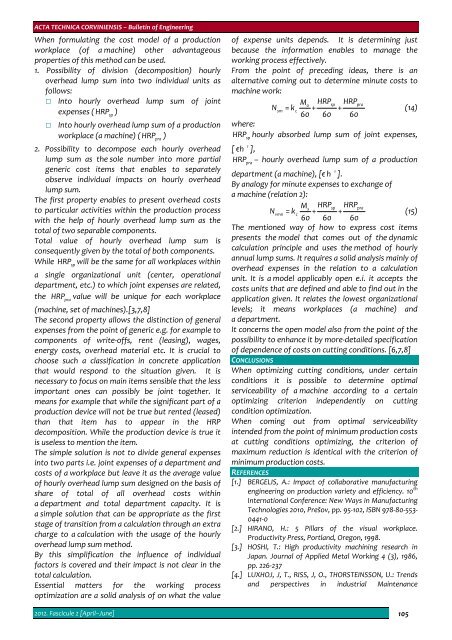Editorial & Advisory Board - Acta Technica Corviniensis
Editorial & Advisory Board - Acta Technica Corviniensis
Editorial & Advisory Board - Acta Technica Corviniensis
You also want an ePaper? Increase the reach of your titles
YUMPU automatically turns print PDFs into web optimized ePapers that Google loves.
ACTA TECHNICA CORVINIENSIS – Bulletin of Engineering<br />
When formulating the cost model of a production<br />
workplace (of a machine) other advantageous<br />
properties of this method can be used.<br />
1. Possibility of division (decomposition) hourly<br />
overhead lump sum into two individual units as<br />
follows:<br />
Into hourly overhead lump sum of joint<br />
expenses ( HRP )<br />
sp<br />
Into hourly overhead lump sum of a production<br />
workplace (a machine) ( HRP<br />
pra<br />
)<br />
2. Possibility to decompose each hourly overhead<br />
lump sum as the sole number into more partial<br />
generic cost items that enables to separately<br />
observe individual impacts on hourly overhead<br />
lump sum.<br />
The first property enables to present overhead costs<br />
to particular activities within the production process<br />
with the help of hourly overhead lump sum as the<br />
total of two separable components.<br />
Total value of hourly overhead lump sum is<br />
consequently given by the total of both components.<br />
While HRPsp<br />
will be the same for all workplaces within<br />
a single organizational unit (center, operational<br />
department, etc.) to which joint expenses are related,<br />
the HRPpra<br />
value will be unique for each workplace<br />
(machine, set of machines).[3,7,8]<br />
The second property allows the distinction of general<br />
expenses from the point of generic e.g. for example to<br />
components of write‐offs, rent (leasing), wages,<br />
energy costs, overhead material etc. It is crucial to<br />
choose such a classification in concrete application<br />
that would respond to the situation given. It is<br />
necessary to focus on main items sensible that the less<br />
important ones can possibly be joint together. It<br />
means for example that while the significant part of a<br />
production device will not be true but rented (leased)<br />
than that item has to appear in the HRP<br />
decomposition. While the production device is true it<br />
is useless to mention the item.<br />
The simple solution is not to divide general expenses<br />
into two parts i.e. joint expenses of a department and<br />
costs of a workplace but leave it as the average value<br />
of hourly overhead lump sum designed on the basis of<br />
share of total of all overhead costs within<br />
a department and total department capacity. It is<br />
a simple solution that can be appropriate as the first<br />
stage of transition from a calculation through an extra<br />
charge to a calculation with the usage of the hourly<br />
overhead lump sum method.<br />
By this simplification the influence of individual<br />
factors is covered and their impact is not clear in the<br />
total calculation.<br />
Essential matters for the working process<br />
optimization are a solid analysis of on what the value<br />
of expense units depends. It is determining just<br />
because the information enables to manage the<br />
working process effectively.<br />
From the point of preceding ideas, there is an<br />
alternative coming out to determine minute costs to<br />
machine work:<br />
M HRP HRP<br />
0 sp pra<br />
Nsm = kc<br />
+ +<br />
(14)<br />
60 60 60<br />
where:<br />
HRPsp<br />
hourly absorbed lump sum of joint expenses,<br />
1<br />
[ € h ],<br />
HRP<br />
pra<br />
– hourly overhead lump sum of a production<br />
1<br />
department (a machine), [€ h ].<br />
By analogy for minute expenses to exchange of<br />
a machine (relation 2):<br />
M HRP HRP<br />
s sp pra<br />
Nvmn = kc<br />
+ +<br />
(15)<br />
60 60 60<br />
The mentioned way of how to express cost items<br />
presents the model that comes out of the dynamic<br />
calculation principle and uses the method of hourly<br />
annual lump sums. It requires a solid analysis mainly of<br />
overhead expenses in the relation to a calculation<br />
unit. It is a model applicably open e.i. it accepts the<br />
costs units that are defined and able to find out in the<br />
application given. It relates the lowest organizational<br />
levels; it means workplaces (a machine) and<br />
a department.<br />
It concerns the open model also from the point of the<br />
possibility to enhance it by more‐detailed specification<br />
of dependence of costs on cutting conditions. [6,7,8]<br />
CONCLUSIONS<br />
When optimizing cutting conditions, under certain<br />
conditions it is possible to determine optimal<br />
serviceability of a machine according to a certain<br />
optimizing criterion independently on cutting<br />
condition optimization.<br />
When coming out from optimal serviceability<br />
intended from the point of minimum production costs<br />
at cutting conditions optimizing, the criterion of<br />
maximum reduction is identical with the criterion of<br />
minimum production costs.<br />
REFERENCES<br />
[1.] BERGELIS, A.: Impact of collaborative manufacturing<br />
engineering on production variety and efficiency. 10 th<br />
International Conference: New Ways in Manufacturing<br />
Technologies 2010, Prešov, pp. 95‐102, ISBN 978‐80‐553‐<br />
0441‐0<br />
[2.] HIRANO, H.: 5 Pillars of the visual workplace.<br />
Productivity Press, Portland, Oregon, 1998.<br />
[3.] HOSHI, T.: High productivity machining research in<br />
Japan. Journal of Applied Metal Working 4 (3), 1986,<br />
pp. 226‐237<br />
[4.] LUXHOJ, J, T., RISS, J, O., THORSTEINSSON, U.: Trends<br />
and perspectives in industrial Maintenance<br />
2012. Fascicule 2 [April–June] 105

















